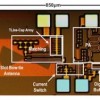Optoelectronic device with multiple quantum wells
Scientists have found that two-dimensional (2D) nanostructures with asymmetric design enable a new quantum mechanism, triggering the emission of tunable light at terahertz frequencies—with unprecedented efficiency.
The researchers, from the University of Southampton and Imperial College London, found that quantum wells, 2D nanostructures formed of several layers of semi-conductor alloys placed on top of each other like a sandwich, can enhance light emission in a technological challenging spectral range.


 Keck Foundation grant to Rice University bolsters cutting-edge research for communications, imaging
Keck Foundation grant to Rice University bolsters cutting-edge research for communications, imaging Rice University researchers' chemical process may improve manufacturing
Rice University researchers' chemical process may improve manufacturing

























































































